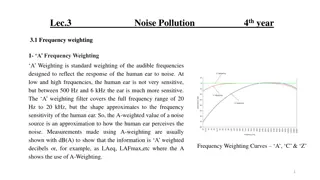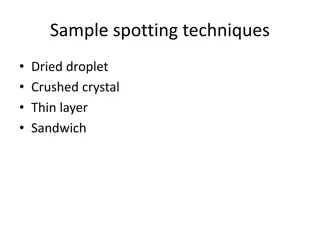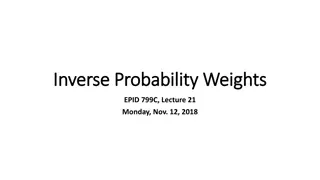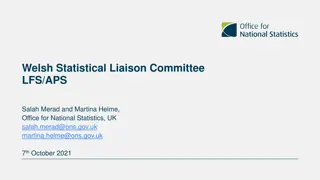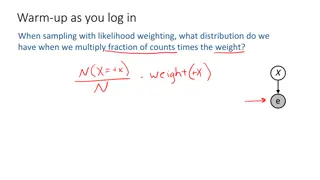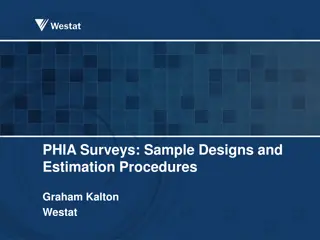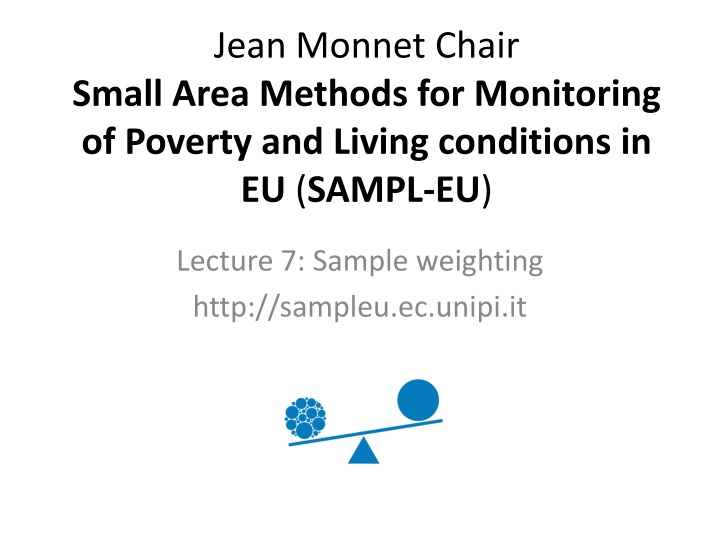
Monitoring Poverty and Living Conditions in EU: Sample Weighting Methods
Discover the Sample Weighting Methods used in the SAMPL-EU project for monitoring poverty and living conditions in the European Union. Explore the sample design, selection process, and probability of inclusion for households in different zones, providing insights into effective data collection strategies.
Download Presentation

Please find below an Image/Link to download the presentation.
The content on the website is provided AS IS for your information and personal use only. It may not be sold, licensed, or shared on other websites without obtaining consent from the author. If you encounter any issues during the download, it is possible that the publisher has removed the file from their server.
You are allowed to download the files provided on this website for personal or commercial use, subject to the condition that they are used lawfully. All files are the property of their respective owners.
The content on the website is provided AS IS for your information and personal use only. It may not be sold, licensed, or shared on other websites without obtaining consent from the author.
E N D
Presentation Transcript
Jean Monnet Chair Small Area Methods for Monitoring of Poverty and Living conditions in EU (SAMPL-EU) Lecture 7: Sample weighting http://sampleu.ec.unipi.it
Example: estimation for domains Happy Land Food Survey Stratified two stage sample survey H=5 strata; N=20000 households A= 200 villages in HL (clusters) a=50 sampled villages n=500 households Complete coverage of the target population Full response of the interviewed households
Target Population (households in HL) Divided into 4 Zones Central HL Eastern HL Southern HL Northern HL Western HL 50 50 50 50 50 villages villages villages villages villages Every village:200 households Every village:200 households Every village:200 households Every village:200 households Every village:200 households
Sample design and selection (ultimate sampling units households in HL) Divided into 4 Strata stratification Southern HL Eastern HL Western HL Northern HL Central HL 1st STAGE selection Srs of 10 clusters out of 50 clusters Srs of 13 clusters out of 50 clusters Srs of 6 clusters out of 50 clusters Srs of 7 clusters out of 50 clusters Srs of 14 clusters out of 50 clusters 2ndSTAGE selection Srs of 10 hhs out of 200 hhs Srs of 10 hhs out of 200 hhs Srs of 10 hhs out of 200 hhs Srs of 10 hhs out of 200 hhs Srs of 10 hhs out of 200 hhs
Probability of inclusion of k-th hh This is what I need: 1/ k=ak Sampling weight for the k-th household k= hi x hk|i hi probability of inclusion of the village (h-th stratum) hk|i probability of inclusion of the household, given that the i-th village is included (h-th stratum)
# Package "laeken" # Package "laeken" # Estimation of Laeken indicators using synthetic EU-SILC data # description of the EU-SILC survey: # http://ec.europa.eu/eurostat/web/microdata/european-union-statistics- on-income-and-living-conditions # load the library (necessary to install it in R the first time it is used) library(laeken) # load synthetic Austrian EU-SILC data data(eusilc) dim(eusilc)
# Package "laeken" # A data frame with 14827 observations on the following 28 variables: # db030 integer; the household ID. # hsize integer; the number of persons in the household. # db040 factor; the federal state in which the household is located (levels Burgenland, Carinthia, Lower Austria, Salzburg, Styria, Tyrol, Upper Austria, Vienna and Vorarlberg). # rb030 integer; the personal ID. . . . # db090 numeric; the household sample weights. # rb050 numeric; the personal sample weights.
# Package "laeken" # AT-RISK-OF-POVERTY RATE # at-risk-of-poverty rate: national level arpr(eusilc$eqIncome, weights = eusilc$rb050, design =eusicl$db040) # at-risk-of-poverty rate: federal states level (NUTS 2) arpr(eusilc$eqIncome, weights = eusilc$rb050, design =eusilc$db040, breakdown = eusilc$db040) Federal state indicator
# Package "laeken" # computing confidence intervals: national level a <- arpr(eusilc$eqIncome, weights = eusilc$rb050, design =eusicl$db040) bootVar(inc=eusilc$eqIncome, weights = eusilc$rb050, design =eusilc$db040, indicator=a, R=1000, bootType="naive", ciType="perc") # computing confidence intervals: federal states level (NUTS 2) a.states <- arpr(eusilc$eqIncome, weights = eusilc$rb050, design=eusilc$db040, breakdown=eusilc$db040) bootVar(inc=eusilc$eqIncome, weights = eusilc$rb050, design =eusilc$db040, indicator=a.states, breakdown=eusilc$db040, R=1000, bootType="naive", ciType="perc")
Statistically sound estimate 1 In descriptive statistics: the coefficient of variation (CV) is the ratio of the standard deviation to the value of the mean Coefficient of Variation = (Standard Deviation/ mean) * 100. For example, the expression The standard deviation is 15% of the mean is a coefficient of variation. Title/date
Statistically sound estimate 2 In descriptive statistics: the CV is particularly useful when you want to compare variability of two different groups or populations. For example: Income in Pop A has CV=15%, Income in Pop B has CV=30%...the distribution of income in Pop B has more dispersion (is more variable) Title/date
Statistically sound estimate 3 In Statistical Inference: the coefficient of variation (CV) is the ratio of the standard error of an estimate to the value of the estimate Coefficient of Variation = (Standard Error / Estimate) * 100. For example, the expression The standard error is 15% of the estimate is a coefficient of variation. Title/date
Statistically sound estimate 3 In Statistical Inference: For example: estimator A has CV=15%, estimator B has CV=30%...the sampling distribution of estimator B has more dispersion (is more variable) and the estimator B is less efficient than A Title/date
Statistically sound estimate 4 In sample survey (Inference) The CV is particularly useful when you want to assess the accuracy (efficiency + unbiasdeness) of the results of a survey (estimate): The MSE (Mean Squared Error) is equal to Variance + Bias^2 MSE(estimator) = Variance(estimator)+bias(estimator)^2 Coefficient of Variation = square root(MSE(estimate)) /(Estimate) * 100. For example, the expression The sqrt(MSE) is 15% of the estimate is a coefficient of variation and it is a measure of the accuracy of the estimate Title/date
Statistically sound estimate 5 It means accurate, with a low CV. When I say low it means that its value should not exceed the 20-30% of the value of the estimate itself. Many Official Statistical Agencies do not publish estimates with CV higher than 20% Title/date

